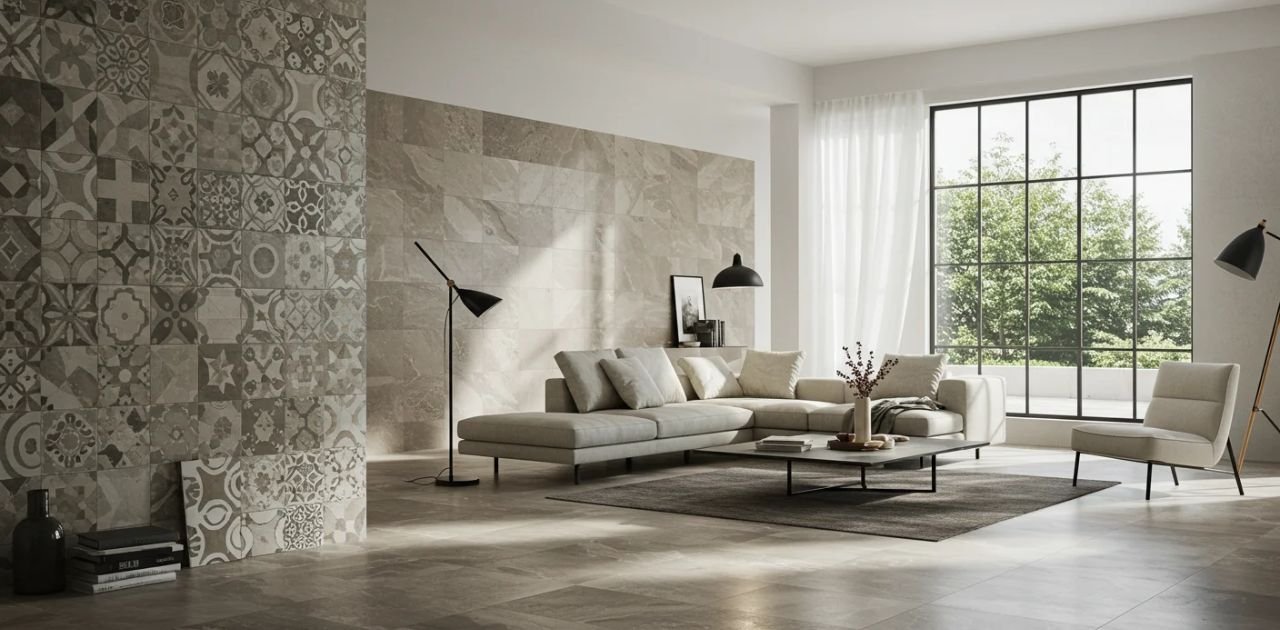When choosing tiles for your home or commercial space, you want the balance of aesthetics, durability, and ease of maintenance. That’s where Sodiceram comes in. As a featured material line at BuiltUp Home, Sodiceram offers a compelling blend of design flexibility and performance suited to today’s architectural demands.
In fact, a detailed overview of its design and technical merits has been published under the title “Sodiceram ceramics” on BuiltUp Home’s site, giving deeper insights into how this material is shaping modern interiors.
Let’s dive into what makes Sodiceram special, how it’s used, and tips for selecting and caring for it.
What Is Sodiceram?
Sodiceram is a next-generation ceramic tile system that enhances conventional ceramics by improving key performance parameters. Compared to standard ceramic tiles, Sodiceram generally offers:
- Higher mechanical strength and resistance to chipping or cracking
- Lower porosity and better moisture resistance
- Broader options in textures, finishes, and sizes
- Longer service life with reduced maintenance demands
These advantages make it a strong candidate for areas exposed to heavy foot traffic, moisture (like bathrooms or kitchens), or exterior environments.
Key Benefits & Features
1. Durability & Structural Integrity
Sodiceram is engineered to withstand wear and tear better than many standard ceramics. Its improved resistance to impact and deformation helps it stay intact even with regular use.
2. Moisture & Stain Resistance
Thanks to its relatively low porosity, Sodiceram tiles resist water absorption and stains more effectively. This is particularly useful in wet areas like showers, kitchens, or outdoor patios.
3. Design Versatility
One of its biggest draws is the aesthetic range. Sodiceram supports multiple finishes — matte, gloss, textured, natural stone-look, wood-look, and patterned tiles. You can mix formats or finishes to achieve design focal points or visual contrast.
4. Low Maintenance
Cleaning Sodiceram is straightforward. Regular sweeping and damp mopping with gentle detergents are usually sufficient. Because it resists stains and moisture, less frequent deep cleaning or sealing is required.
5. Sustainability
Many Sodiceram collections are made with eco-friendly processes. Manufacturers emphasize reduced waste, recycling of materials, and energy-efficient firing. The longevity of the material also means fewer replacements over time, which is an environmentally favorable trait.
Applications & Use Cases
You’ll find Sodiceram tiles in a variety of settings:
- Residential interiors: living rooms, kitchens, bathrooms, hallways
- Feature walls & accent surfaces: decorative mosaics, niche walls
- Commercial spaces: lobbies, restaurants, retail stores where durability is vital
- Outdoor and semi-outdoor: patios, terraces, facades (with frost-resistant or anti-slip variants)
Because of its flexibility in finish and texture, designers often turn to Sodiceram to create continuity between interior and exterior spaces.
Choosing the Right Sodiceram Tile
Here are some tips to help select the appropriate Sodiceram tile for your project:
| Consideration | Guidance |
| Finish / Texture | For wet or slippery zones, favor matte or textured surfaces over glossy ones to reduce slip risk. |
| Tile Size & Format | Larger-format tiles reduce grout lines and visually open up spaces; smaller tiles or mosaics are great for accents. |
| Slip & Safety Ratings | For bathrooms, pool zones, or exterior areas, ensure the tile meets anti-slip ratings appropriate for use. |
| Installation Substrate | The base surface should be clean, level, and properly prepared to avoid uneven stresses or detachment. |
| Grout & Sealing | Use proper grout systems as recommended and consider sealing (if needed) to enhance longevity. |
Maintenance & Care
- Sweep or vacuum regularly to remove grit that can scratch surfaces
- Mop with warm water and mild detergent; avoid harsh acids or abrasive cleaners
- Wipe up spills promptly to prevent staining
- For outdoor installations, rinse occasionally to remove accumulated dirt
- Periodically inspect grout lines and perform touch-ups or resealing when necessary
With proper care, Sodiceram tiles can maintain their visual appeal and performance for decades.
Sodiceram vs Traditional Ceramics (and Other Alternatives)
| Metric | Traditional Ceramic | Sodiceram | Other Alternatives (e.g. Vinyl, Wood) |
| Durability | Good, but more prone to cracking or chipping under stress | Enhanced resistance to impact & deformation | Varies; wood vulnerable to moisture, vinyl less hard |
| Moisture / Stain Resistance | Moderate | Superior | Vinyl good for moisture, wood less ideal |
| Design / Aesthetic Flexibility | Many options, but some limits | Very broad in textures, formats, custom finishes | Wood gives natural warmth; vinyl more limited |
| Maintenance | Requires sealing in some cases, careful cleaning | Generally easier due to stain resistance | Vinyl easy; wood demands periodic finishing |
| Lifespan | 10–25+ years (depending on conditions) | Longer, especially in demanding environments | Wood subject to wear; vinyl may degrade or peel |
In many cases, Sodiceram provides a middle ground: combining many of the design perks of ceramics with enhanced durability and lower upkeep.
Why Choose Sodiceram Through BuiltUp Home?
By sourcing Sodiceram via BuiltUp Home, you gain access not only to the material itself but also relevant support in selection, specification, and installation guidance. The in-depth article “Sodiceram ceramics” on their website offers design inspiration and technical insight to help you match the right product to your space.
Whether you’re remodeling a home, finishing a commercial space, or working on a façade project, the combination of expert support and high-performance materials makes that route appealing.
Conclusion
Sodiceram tiles stand out as a modern and intelligent choice for those who refuse to compromise between beauty and durability. With superior moisture resistance, versatility in design, and reduced maintenance demands, it addresses many challenges faced in both residential and commercial environments.
When properly selected, installed, and cared for, Sodiceram can serve as a long-lasting foundation for your interiors and exteriors alike. For more detailed insights and visual references, check out BuiltUp Home’s pages on Sodiceram and Sodiceram ceramics.
🏡 Sample Layout Plan: Modern Open-Plan Living & Kitchen
1. Zone Overview
| Zone | Tile Type | Size | Finish | Color Palette | Pattern/Installation |
| Living Room | Sodiceram Large-Format Porcelain | 24″ x 48″ | Matte | Light Grey or Warm Taupe | Straight lay or 45° diagonal for added dimension |
| Kitchen Floor | Sodiceram Anti-Slip Tiles | 12″ x 24″ | Textured | Charcoal or Graphite | Brick/Running Bond |
| Kitchen Backsplash | Sodiceram Mosaic Sheets | 2″ x 2″ | Gloss | White with Subtle Veins | Staggered Mosaic |
| Accent Wall (TV area) | Sodiceram Stone-Look Panels | 12″ x 36″ | Natural Matte | Slate Grey or Beige | Vertical Stacking |
| Dining Transition Strip | Metallic or Brass-Look Trim | N/A | N/A | Matches kitchen hardware | Linear Divider |
2. Layout Highlights
Living Room
- Main Field Tiles: Use 24″ x 48″ large-format Sodiceram tiles in light grey to create a seamless, open feel.
- Grout: Use color-matched grout (light grey) to minimize visible lines and enhance the modern aesthetic.
Kitchen Floor
- Durability First: Opt for anti-slip textured Sodiceram tiles (12″ x 24″) in a darker tone like charcoal to hide spills and foot traffic.
- Pattern: A running bond pattern offers visual movement while maintaining a sleek look.
Kitchen Backsplash
- Focal Element: Sodiceram mosaic sheets in glossy white or subtle marbled veins add texture and light reflection.
- Maintenance Tip: Seal grout to protect from food splashes.
Accent Wall
- Feature Statement: Install stone-look Sodiceram tiles vertically behind the TV or a fireplace to create a natural focal point.
- Lighting: Add LED strip lighting to highlight the texture.
3. Design Tips
✅ Color Harmony: Keep a cohesive neutral palette across zones for visual continuity.
✅ Texture Play: Combine matte floor tiles with glossy backsplash mosaics for depth and contrast.
✅ Zoning with Patterns: Use different tile sizes or patterns to subtly separate living, dining, and kitchen spaces without physical barriers.
✅ Metallic Accents: Brass or stainless trims between zones elevate the luxury feel.
4. Suggested Installation Sequence
- Prepare subfloor and level surfaces.
- Install living room large-format tiles first for easier alignment.
- Lay kitchen anti-slip tiles next, ensuring a seamless transition strip.
- Finish with backsplash mosaics and accent wall panels for the final decorative touch.
🌟 Pro Tip
For more inspiration and technical details, visit
🔗 Sodiceram – Full product overview
🔗 Sodiceram ceramics – Design ideas & durability guide

